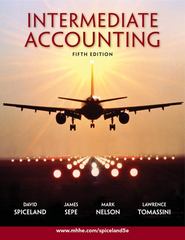Question
Asia Pacific Ltd started operating on 1 July 2017 with 12 employees. Three years later all of those employees were still with the company. On
Asia Pacific Ltd started operating on 1 July 2017 with 12 employees. Three years later all of those employees were still with the company. On 1 July 2019 the company hired 15 more people but by 30 June 2020 only 10 of those employed at the beginning of that year were still employed by Asia Pacific Ltd.
All employees are entitled to 13 weeks' long-service leave after a conditional period of 10 years of employment with Asia Pacific Ltd.
At 30 June 2020 Asia Pacific Ltd estimates the following:
The aggregate annual salaries of all employees hired on 1 July 2017 is now $1,200,000.
The aggregate annual salaries of all current employees hired on 1 July 2019 is now $800,000.
The probability that employees hired on 1 July 2017 will continue to be employed for the duration of the conditional period is 40 per cent.
The probability that employees hired on 1 July 2019 will continue to be employed for the duration of the conditional period is 20 per cent.
Salaries are expected to increase indefinitely at 1 per cent per annum.
The interest rates on high-quality corporate bonds are as follows:
Corporate bonds maturing in seven years 6%
Corporate bonds maturing in eight years 8%
Corporate bonds maturing in nine years 8%
Corporate bonds maturing in ten years 10%
At 30 June 2019 the provision for long-service leave was $12,000. Required:
a) Calculate the total accumulated long-service leave benefit as at 30 June 2020. (3 marks)
b) What amount should be reported for the long-service leave provision as at 30 June 2020 in accordance with AASB 119? (3 marks)
c) Prepare the journal entry for the provision for long-service leave for 30 June 2020 in accordance with AASB 119. (3 marks)
d) Which employee benefits are required to be discounted in accordance with AASB 119?
Note:
1. Examine conceptual issues and the sources of authority for the accounting requirements which apply to reporting by Australian companies, including Company Law, International and Australian Accounting Standards, and Stock Exchange requirements; 2. Understand and evaluate different theories of accounting such as positive accounting theory, normative accounting theory, stakeholders' theory, legitimacy theory, institutional theory, and different initiatives of relevant global organisations such as GRI, IR; 3. Apply Australian Accounting Standards and Corporate Legislation to the financial reporting processes; 4. Evaluate advanced level financial accounting problems and select appropriate accounting strategies for the accounting entity; 5. Understand different provisions of accounting standards and the compliance requirements of the professional and legal bodies in Australia; 6. Make judgments about appropriate use of accounting standards and accurately apply appropriate treatments for different advanced level accounting issues;
Step by Step Solution
There are 3 Steps involved in it
Step: 1

Get Instant Access to Expert-Tailored Solutions
See step-by-step solutions with expert insights and AI powered tools for academic success
Step: 2

Step: 3

Ace Your Homework with AI
Get the answers you need in no time with our AI-driven, step-by-step assistance
Get Started


